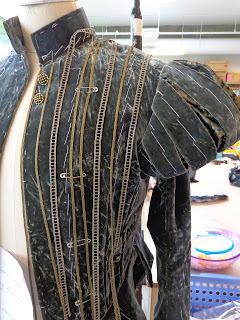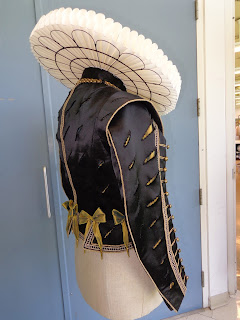There are a lot of things to consider when making Trunk hose.
How to get the shape or silhouette you desire is first and foremost, and how you are going to put them together is another. Bulky seam allowances and overall weight come into consideration as well. How are they going to close? How do you marry the support structure and the outer fashion layers successfully?
Remember there is no one official way to achieve this- experimentation is key!
In the distant past, I remember seeing cutters constructing the trunk-hose shape by stitching rows of gathered tulle onto a fitted trouser base much like one would when constructing a tutu, then shaping the silhouette by trimming the tulle.
Quite a lot of work to prepare, but a very sculptural approach as you cut away the tulle into the shape you desire. It is like giving the tulle a haircut to get the shape!
If the tulle is stitched densely the shape is firm and stays firm for many years.
Once the shape is achieved the cut edges of the tulle can be a problem with abrading the covering fabric so either the tulle usually needs to be covered or the pouf fabric needs a backing.
I think that approach works well for a pair of the very short Elizabethan trunk hose, the amount of area to be covered is small and the density and weight of layers of tulle is minimal.
If I am making a larger volume trunk hose or slop style I usually start with a fitted base pair of breeches. How fitted they are depends on the look you are trying to achieve, particularly in the placement and fit of the canion area.
Here is the base front for the really large comedy breeches. I have marked in a line below the waist where the top hip roll may sit, and also lines mid leg for the crin ruffle. Closer to the finished length, I mark the area where the grosgrain
(we are cartridge pleating the lower leg to grosgrain) will come to and where the lower edge of the crin will come to. I offset the crin from the waist and lower leg seam to eliminate bulk in those seams.
Here is the crin sewn to the mid leg lines. I think we decided to move them closer together than where I had originally marked after seeing how it looked on the stand.
The base will be made with a zip front closure and you can see a waistband has been sewn on with the finished side to the inside.
We tried a gathered single layer of heavier crin at the waist here, but it didn't give much of a "shelf" so we gathered up that loose edge and made a "hip roll"
You can create "hip rolls" by cutting a rectangle or oblong shape of crin to start. Cut the crin double the finished width you need. Serge the cut edges of the crin. Sew gathering stitches along each long edge of the crin. Use a heavy thread like Bell thread in the bobbin to reduce thread breakage and frustration!
Gather the long edges of the shape down to the size you wish and sew each gathered edge to a piece of twill tape. You can then sew one twill tape edge to the base, and sew the other edge below it in a parallel line. If you sew them close together you get more horizontal distance and rigidity and further apart will give a more gentle shape and support. Crin comes in different weight, so that can be used to your advantage if you use the heavier for the area that needs more support, and the lighter for less.
We have found that sewing the crin into modular forms is easier to move around to create shapes.
I think that sewing the crin directly to the fitted under base can be a nightmare to modify or alter, so we are trying to attach it first to twill tape, then sew the twill tape to the base. if you want to move a layer up or down, it is a simple matter to unpick it and sew it elsewhere.
I also like to use the light crin as an overall under layer/pouf to both give shape and to protect the outer fabric. You can see that it has been sewn on so that it rolls up and over for a bit more lift. you can see that there is still an inch of space there below the waistband as I want to leave space for the seam allowance of the fashion fabric once we get to that layer.
At this point, we draped the mock up leg over the shape to see if this was heading in the right direction.
I darted (horizontally) the large piece of crin at the front and back edges at the level of the mid leg to reinforce the shape and to reduce excess length in those areas.
We will tack the mid leg riffle to the out bag so it doesn't fall down. I think if this needed even more support I could sew in a horizontal piece of nylon boning to support the circumference, but I will wait and see what the designer thinks first.
It is a good idea as you are going along to think of what you can do to make changes if required. Not everything works as well as you might hope the first time so have a strategy!
Once one side is good, we do the same to the other side and then sew the two legs together. This pair is going to get big fast! Sideways through the door big.

































